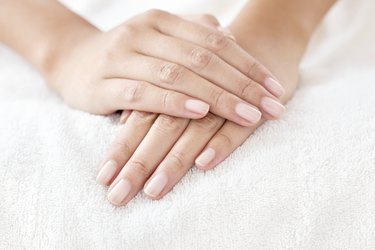
A person's fingernails can tell you a lot about their hygiene and fashion sense. But did you know that the appearance of your nails can also clue you into certain aspects of your overall health?
Splitting nails, for example, can indicate a health issue or that something is off with your diet. Here, learn what causes fingernails to split down the middle — and the misconceptions around this issue you should stop believing.
Video of the Day
Video of the Day
Tip
Cracked or split nails may be caused by a lack of iron in your diet.
Is Nail Splitting Caused by Protein Deficiencies?
Cracked and split fingernails are not necessarily caused by a lack of protein in the diet. They're usually caused by environmental factors. An iron deficiency is the most likely nutritional cause and can be improved by boosting both iron and biotin in the diet — nutrients found in some protein-rich foods.
Vertical Cracks in Nails
Ridges that run longitudinally from the base of the nail to the tip can be a symptom of autoimmune disease, especially if there are multiple ridges that make striations across the whole surface of the nail. Cracks can form with the ridges, especially at the tip of the nail.
A single, central ridge or vertical split down the middle of the nail is more likely to be the result of injury rather than an indicator of disease. However, a central ridge or fissure can also indicate a dietary deficiency in iron.
Excess Moisture and Dryness
Nails can crack and split when they become too wet or too dry. Exposing the hands to cycles of wetting and drying during household chores, like dishwashing, takes a toll on fingernails. Nails that get wet too often become soft and weak.
Dry heat and low humidity during winter are typical causes of cracked, split fingernails. Moisture evaporates easily from nails, and low humidity and temperature extremes contribute to nail dehydration. Nails that are too dry become brittle, which can cause cracking and splitting more easily.
Using chemical cleaners and acetone nail polish remover can also result in cracked, brittle nails. Avoid mechanical trauma to nails by wearing gloves when washing dishes and for other cleaning chores, and choose a nonacetone polish remover. Hand sanitizers can also dry out nails and cause them to split.
Dietary Deficiency and Split Fingernails
Less common than mechanical trauma, nutrient deficiencies can also lead to brittle nails. According to the American Osteopathic College of Dermatology, low iron is typically the culprit for brittle nails caused by a deficiency. Increase the iron in your diet by eating more:
- Meat
- Poultry
- Seafood
- Legumes
- Dark, leafy greens
Related Reading
Supplements: A Proactive Approach
Biotin is a necessary nutrient for healthy nail formation and growth. Taking a biotin supplement may help strengthen fingernails and prevent splitting and cracking. Supplementing with 2 to 3 milligrams per day can improve brittle fingernails after six months of daily use, according to the American Osteopathic College of Dermatology.
If no improvement is evident after six months of supplementation, biotin is probably not the solution. Pregnant people should avoid taking supplemental biotin.
Misconceptions About Protein Deficiency
While cracked nails are not caused by a protein deficiency per se, they may result from a deficiency in nutrients associated with high-protein foods. The amount of protein consumed may be sufficient, but the types of proteins consumed may result in an iron or biotin deficiency.
Biotin often binds with proteins, so some protein-rich foods are also rich in biotin. Good dietary sources of biotin include egg yolks and liver. Nonmeat sources of biotin include nuts, legumes and dairy products. Many foods high in iron are also good sources of protein, such as meats and fish.
Dietary Protein Requirements
Americans generally don't have trouble getting enough protein in their diets. The recommended amount of protein is about 0.8 gram per kilogram of body weight or 0.36 gram per pound. For example, a 165-pound person should consume about 60 grams of protein per day.
- American Osteopathic College of Dermatology: Brittle, Splitting Nails
- Cleveland Clinic: Nails and Your Health
- Indian Dermatology Online Journal: Nail as a Window of Systemic Disease
- Oregon State University: Linus Pauling Institute: Biotin
- Oregon State University: Linus Pauling Institute: Iron
- Harvard T.H. Chan School of Public Health: Protein
- National Institutes of Health: Office of Dietary Supplements: Iron
Is this an emergency? If you are experiencing serious medical symptoms, please see the National Library of Medicine’s list of signs you need emergency medical attention or call 911.